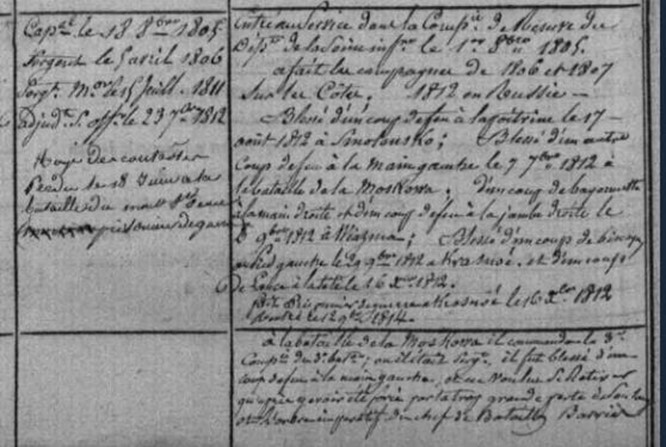
Most regimental register entries give a few scant details of a man’s enrolment, unit, campaigns fought, and demise/discharge. Not so for Felix Dieppedalle, who rose to Adjutant Sous Officier in 17eme Ligne – and whose record tells a fascinating (if fragmentary) tale. 1/ 

Felix Dieppedalle (or Jean Felix, on his initial inscription record) was born in Rouen on 4 August 1782. He was conscripted in 1805 and placed in the Company of Reserve of his department of Seine-Inférieure. He was 165cm tall, just above average for the time. 2/
He clearly made an impression; within three weeks he was promoted corporal, and after six months sergeant. He spent 1806-7 on coastal garrison duty.
In May 1811, he transferred to 17eme Ligne, where the good impression continued. He was promoted sergeant major on 16 July. 3/
In May 1811, he transferred to 17eme Ligne, where the good impression continued. He was promoted sergeant major on 16 July. 3/
On 1 September 1811, however, Dieppedalle was demoted to fourrier (a step between corporal and sergeant). The records are silent on the reason. He was also moved from 5th battalion to 2nd – although the next year found him in 3rd bn! 4/
The 1812 campaign in Russia is where Dieppedalle’s record really becomes interesting. It was his first campaign – and one full of action. The five battalions of Dieppedalle’s 17eme Ligne were placed in Morand’s 1st Division, part of Davout’s I Corps. 5/ 

Their first major engagement came at Smolensk on 17 August. Arriving overnight as reinforcements, the 17eme was thrown into action. Dieppedalle was in the thick of things, and was shot in the chest – a casualty of his first battle. 6/
But the wound was apparently not too serious, as Dieppedalle was back in his company, in the rank of sergeant, for Borodino. And here his record really departs from the norm, giving a highly unusual brief narrative of his part in the action. 7/
It states: “At the Battle of Moskowa he commanded 3rd Coy of 3rd bn, where he was sergeant. He was wounded by a shot to the left hand and refused to retire to the rear until forced by great loss of blood and the imperative order of Chef de Bataillon Barriès” 8/ 

It’s worth repeating that almost no soldiers have individual acts cited in their records, so Dieppedalle’s actions must have stood out beyond the thousands of other instances of heroism. Two weeks after Borodino, he was promoted to Adjutant Sous Officier. 9/
His wound clearly having healed, Dieppedalle then fought through the retreat from Moscow with the 17eme. At the Battle of Wiasma on 3 Nov 1812 he was bayonetted through the right hand and shot in the right leg. He nevertheless continued to march with his regiment. 10/
At Krasnoi in mid-November Dieppedalle was one of 9000 men still with the colours in Davout’s much-reduced corps. Either here or on 29 Nov (record incorrectly claims battle was on 29th) he received a fifth wound of the campaign, hit in the left foot by grapeshot. 11/
Although wounded in leg and foot, he struggled on. But his luck (if it can be called that) was running low. No details are recorded, but on 16 December 1812 Dieppedalle was struck in the head by a lance in a minor clash, and taken prisoner. 12/ 

Dieppedalle remained a prisoner of war in Russia until returning to France on 12 November 1814. His wounds had evidently healed, as on his return he was re-enrolled in 17eme – possibly looking forward to a life of quiet peacetime garrison duty. 13/
But of course, Napoleon’s return in 1815 changed all that. Dieppedalle, as Adjutant Sous Officier, marched with 17eme in the fateful Hundred Days campaign. The last entry in his record states ‘lost on 18 June at the Battle of Mont St Jean, dead or prisoner of war’ 14/
Or very nearly the last entry – as someone later scratched out the words ‘dead or’, hinting that he later turned up as a prisoner of war. It would be nice to think that Felix Dieppedalle returned home to Rouen, with enough stories from his two campaigns to last a lifetime. End/
I probably should have mentioned from the start that this is a #Napoleonic service record!
• • •
Missing some Tweet in this thread? You can try to
force a refresh






